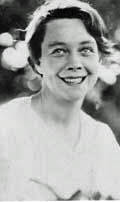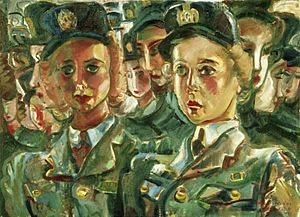Pegi Nicol MacLeod facts for kids
Quick facts for kids
Pegi Nicol MacLeod
|
|
|---|---|

Pegi Nicol MacLeod, 1936
|
|
| Born |
Margaret Kathleen Nichol
January 17, 1904 Listowel, Ontario
|
| Died | February 12, 1949 (aged 45) |
| Education | Art Association of Ottawa school, École des Beaux-Arts de Montréal |
| Known for | Painter |
| Spouse(s) |
Norman MacLeod
(m. 1936) |
Pegi Nicol MacLeod (born Margaret Kathleen Nichol; January 17, 1904 – February 12, 1949) was a talented Canadian painter. She was known for her modern style, especially her self-portraits, paintings of people, children, and landscapes. Her art often featured flowing shapes and bright colors. Besides being a painter, she was also a teacher, a war artist, and someone who actively supported the arts. In 1936, she joined the Canadian Society of Painters in Water Colour, and a year later, the Canadian Group of Painters.
Contents
Biography
Pegi Nicol MacLeod was born in Listowel, Ontario. Her parents were William Wallace Nichol and Myrtle Ivy Riggs. She was their only child. In 1908, when Pegi was four, her family moved to Ottawa. Her father became the principal of the Ottawa Technical School. The family lived on Frank Street, and Pegi went to Cartier Street School.
In 1914, when World War I began, her family moved to Toronto. Pegi attended Harbord Collegiate Institute there. After the war, the Nichols returned to Ottawa. Pegi finished her early schooling at the Ottawa Collegiate Institute.
Art Education
In 1921, Pegi MacLeod started studying art at the Art Association of Ottawa school. She learned from the artist Franklin Brownell from 1922 to 1923. In 1923, she moved to Montreal to study at the École des Beaux-Arts de Montréal. There, she was taught by Edwin Holgate.
The school focused a lot on drawing people and studying the human body. An art critic named Donald Buchanan said that this training made Pegi and many of her classmates interested in painting figures and portraits. She studied alongside other artists who later became famous, like Paul-Émile Borduas and Emily Carr. In 1932, she won the Willingdon Arts Competition prize for her painting.
Personal Life
Pegi lived in Toronto from 1934 to 1937. During this time, she became good friends with Eric Brown. He was the first director of the National Gallery of Canada. Through Brown and his wife, Pegi met many artists in Ottawa, Toronto, and Montreal. She also met important people in Canadian culture, like Vincent Massey.
On December 10, 1936, she married Norman MacLeod. The couple then moved to New York City. However, Pegi returned every year to Fredericton, New Brunswick. In 1940, she and Lucy Jarvis opened an art center there. It was located at the University of New Brunswick and was a place for young artists to learn.
Artistic Career
Pegi MacLeod painted both people and landscapes. Her artworks often showed a thoughtful and kind view of the world, even if they sometimes seemed serious. In 1927 and 1928, she traveled to Western and Northwestern Canada. This trip was encouraged by Marius Barbeau, who studied different cultures. Thanks to Barbeau and the Canadian Pacific Railway, Pegi traveled for free.
She painted in the Rocky Mountains and among the Stoney First Nations people. In British Columbia, MacLeod met the artist Emily Carr. Carr's work influenced Pegi's own art. Pegi stayed with the F.G. Garbutt family in Calgary, who were big supporters of the arts. Pegi painted a portrait of Alice Garbutt, which shows her use of strong lines.
In December 1927, MacLeod showed two of her portraits of the Stoney First Nations. These were part of a big exhibition called West Coast Art – Native and Modern. This show was important because it was one of the first times that art by Northwest Coast First Nations was included in Canadian art history.
Pegi also wrote about her travels for the Canadian National Railway Company's magazine. This was her first important step into writing about art. In 1928, she had a solo exhibition in Montreal called Portraits, Landscapes and Studies. The same year, she was invited to show her work with the famous Group of Seven in Toronto.
In the late 1920s, MacLeod moved from Ottawa to Montreal, and then to Toronto. She worked on window displays for the T. Eaton Company. This job influenced her art, which you can see in her painting A Descent of Lilies (1935). She was also the art editor for The Canadian Forum magazine from 1935 to 1936. She helped start the Picture Loan Society, which helped artists sell their work.
Although Pegi MacLeod was against World War II, she took on a special job in 1944. The National Gallery of Canada asked her to paint scenes of the Women's Division of the Armed Forces. This was a way to show the war from a woman's point of view.
Painting New York City
After World War II, Pegi returned to painting scenes of New York City. In 1947, she showed her oil and watercolor paintings in Toronto, Ottawa, and Fredericton. This collection was called the "Manhattan Cycle." The Manhattan Cycle focused on the people and places around her apartment on East 88th Street in New York. She wrote to her friend, artist Isabel McLaughlin, in 1946 that she had been painting 88th Street for six years and still found it amazing.
By 1947, the Manhattan Cycle included 110 artworks. It was the first time MacLeod showed a series of works in Canada that were completely about her time in New York. The collection also traveled to other cities in 1948, including Winnipeg, Saskatoon, Calgary, Edmonton, Victoria, and Vancouver.
Exhibitions
A large show of her work was held at Galerie Walter Klinkhoff in 1982. Another traveling exhibition was put together by the Robert McLaughlin Gallery in Oshawa in 1984. A book of her letters, with an introduction by Joan Murray, was also published.
Legacy
Pegi MacLeod passed away from cancer in New York City in 1949. She left behind more than a thousand artworks. These include many paintings and other art forms, like designs for hooked rugs. Today, Pegi MacLeod is seen as an important artist. Her work during wartime, which includes over one hundred oil paintings, makes her stand out from many artists of her time.
See also
- Canadian artist
- Woman artists
- Canadian official war artists
- War artist
- War art


